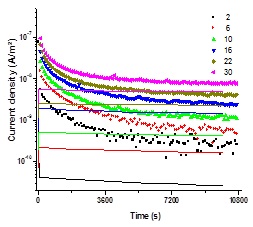Assessment of a Charge Transport Model for LDPE through Conduction Current Measurement
Keywords:
LDPE, conduction current, charge transportAbstract
Conduction current measurements have been widely used to characterize charge transport behavior in insulating materials. However, the interpretation of transport mechanisms and more generally of non-linear processes from current measurements alone is not straightforward. For this reason, space charge measurements, on the one hand, and models of charge transport encompassing charge generation, trapping and transport have been developed. The completeness and accuracy of a model can be assessed only if a substantial range of stress conditions, being field and temperature for the current topics, is available. The purpose of this communication is to enrich the investigation of low density polyethylene - LDPE insulation material characteristic using conduction current measurement. Measurements were conducted on 250 μm thick LDPE samples, for DC fields in the range 2 to 50 kV/mm and for temperatures from 20 to 70°C. Experimental data, i.e. transient current in charge/discharge and quasi-steady state currents are compared to the prediction of a bipolar transport model that has been developed over the last years and fitted to the case of LDPE. The deviation of model results is substantial, with essentially an overestimation of the non-linearity of the current-field dependence. These differences are discussed along with prospects from improving the model. Aside from these modelling approaches, we show that thermal preconditioning of samples appears to be influential in the measured apparent conductivity.

Published
How to Cite
Issue
Section
License
Submission of a manuscript implies: that the work described has not been published before that it is not under consideration for publication elsewhere; that if and when the manuscript is accepted for publication. Authors can retain copyright in their articles with no restrictions. is accepted for publication. Authors can retain copyright of their article with no restrictions.
Since Jan. 01, 2019, AITI will publish new articles with Creative Commons Attribution Non-Commercial License, under The Creative Commons Attribution Non-Commercial 4.0 International (CC BY-NC 4.0) License.
The Creative Commons Attribution Non-Commercial (CC-BY-NC) License permits use, distribution and reproduction in any medium, provided the original work is properly cited and is not used for commercial purposes.



